Mybatis学习
本文最后更新于:June 20, 2022 pm
Mybatis
回顾:
- JDBC
- Mysql
- java基础
- Maven
- Junit
1、简介
1.1、什么是Mybatis

- MyBatis 是一款优秀的持久层框架
- 它支持自定义 SQL、存储过程以及高级映射。
- MyBatis 免除了几乎所有的 JDBC 代码以及设置参数和获取结果集的工作。
- MyBatis 可以通过简单的 XML 或注解来配置和映射原始类型、接口和 Java POJO(Plain Old Java Objects,普通老式 Java 对象)为数据库中的记录。
- MyBatis 本是apache的一个开源项目iBatis, 2010年这个项目由apache software foundation 迁移到了google code,并且改名为MyBatis 。
- 2013年11月迁移到Github。
如何获得Mybatis?
Maven仓库
1
2
3
4
5
6<!-- https://mvnrepository.com/artifact/org.mybatis/mybatis -->
<dependency>
<groupId>org.mybatis</groupId>
<artifactId>mybatis</artifactId>
<version>3.5.5</version>
</dependency>
1.2、持久化
数据持久化
- 持久化就是将程序的数据在持久状态和瞬时状态转化的过程
- 内存:断电即失
- 数据库(jdbc),io文件持久化。
- 生活:冷藏
为什么需要持久化?
- 有一些对象,不能让他丢掉。
- 内存太贵了
1.3、持久层
Dao层,Service层,Controller层
- 完成持久化工作的代码块
- 层界限十分明显
1.4、为什么需要Mybatis?
- 帮助程序员把数据存入数据库中
- 方便
- 传统的JDBC代码太复杂了。简化 框架 自动化
- 不用Mybatis也可以。更容易上手。
- 优点:
- 简单易学:本身就很小且简单。没有任何第三方依赖,最简单安装只要两个jar文件+配置几个sql映射文件易于学习,易于使用,通过文档和源代码,可以比较完全的掌握它的设计思路和实现。
- 灵活:mybatis不会对应用程序或者数据库的现有设计强加任何影响。 sql写在xml里,便于统一管理和优化。通过sql语句可以满足操作数据库的所有需求。
- 解除sql与程序代码的耦合:通过提供DAO层,将业务逻辑和数据访问逻辑分离,使系统的设计更清晰,更易维护,更易单元测试。sql和代码的分离,提高了可维护性。
- 提供映射标签,支持对象与数据库的orm字段关系映射
- 提供对象关系映射标签,支持对象关系组建维护
- 提供xml标签,支持编写动态sql。
最重要的一点:使用的人多
Spring SpringMVC SpringBoot
2、第一个Mybatis程序
思路:搭建环境 —> 导入Mybatis —> 编写代码 —> 测试
2.1、搭建环境
搭建数据库
新建项目
1.新建一个普通的maven项目
2.删除src目录
3.导入maven依赖
1 | |
2.2、创建一个模块
编写mybatis的核心配置文件
1
2
3
4
5
6
7
8
9
10
11
12
13
14
15
16
17
18
19
20<?xml version="1.0" encoding="UTF-8" ?>
<!DOCTYPE configuration
PUBLIC "-//mybatis.org//DTD Config 3.0//EN"
"http://mybatis.org/dtd/mybatis-3-config.dtd">
<!--configuration核心配置文件-->
<configuration>
<environments default="development">
<environment id="development">
<transactionManager type="JDBC"/>
<dataSource type="POOLED">
<property name="driver" value="com.mysql.cj.jdbc.Driver"/>
<property name="url" value="jdbc:mysql://localhost:3306/mybatis?useSSL=false&useUnicode=true&characterEncoding=UTF-8"/>
<property name="username" value="root"/>
<property name="password" value="root"/>
</dataSource>
</environment>
</environments>
</configuration>编写mybatis工具类
1 | |
2.3、编写代码
实体类
1
2
3
4
5
6
7
8
9
10
11
12
13
14
15
16
17
18
19
20
21
22
23
24
25
26
27
28
29
30
31
32
33
34
35
36
37
38
39
40
41
42
43
44
45
46
47
48
49//实体类
public class User {
private int id;
private String name;
private String pwd;
public User() {
}
public User(int id, String name, String pwd) {
this.id = id;
this.name = name;
this.pwd = pwd;
}
public int getId() {
return id;
}
public void setId(int id) {
this.id = id;
}
public String getName() {
return name;
}
public void setName(String name) {
this.name = name;
}
public String getPwd() {
return pwd;
}
public void setPwd(String pwd) {
this.pwd = pwd;
}
@Override
public String toString() {
return "User{" +
"id=" + id +
", name='" + name + '\'' +
", pwd='" + pwd + '\'' +
'}';
}
}Dao接口
1
2
3public interface UserDao {
List<User> getUserList();
}接口实现类由原来的UserDaoImpl转变为一个Mapper配置文件
1
2
3
4
5
6
7
8
9
10<?xml version="1.0" encoding="UTF-8" ?>
<!DOCTYPE mapper
PUBLIC "-//mybatis.org//DTD Mapper 3.0//EN"
"http://mybatis.org/dtd/mybatis-3-mapper.dtd">
<!--namespace绑定一个对应的Dao/Mapper接口-->
<mapper namespace="com.acacac.dao.UserDao">
<select id="getUserList" resultType="com.acacac.pojo.User">
select * from mybatis.user
</select>
</mapper>
2.4、测试
注意点:
org.apache.ibatis.binding.BindingException: Type interface com.acacac.dao.UserDao is not known to the MapperRegistry.
MapperRegistry是什么?
核心配置文件中注册mappers
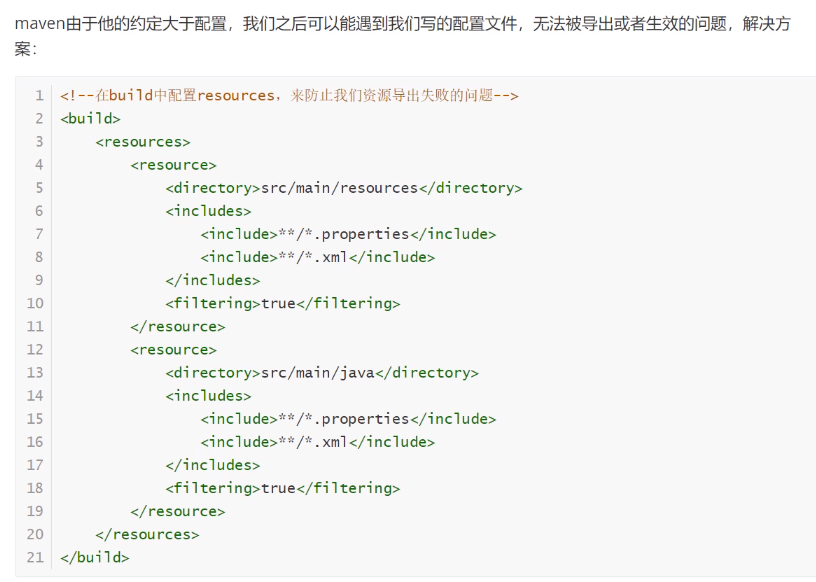
注意
1 | |
- Junit测试
1 | |
可能遇到的问题:
- 1.配置文件没有注册
- 2.绑定接口错误
- 3.方法名不对
- 4.返回类型不对
- 5.Maven导出资源问题
- 6.mybatis-config不能有中文注释
3、CRUD
1、namespace
namespace中的包名要和Dao/mapper接口的包名一致
2、select
选择,查询语句;
- id:就是对应的namespace中的方法名;
- resultTypr:Sql语句执行的返回值
- parameterType:参数类型
1.编写接口
1 | |
2.编写对应的mapper中的sql语句
1 | |
3.测试
1 | |
3、Insert
1 | |
4、update
1 | |
5、delete
1 | |
注意点:
- 增删改需要提交事务
6、常见错误
- 标签不要匹配错
- resource绑定mapper,需要使用路径
- 程序配置文件必须符合规范
- NullPointerException,没有注册到资源
- 输出的xml文件存在中文乱码问题
- maven资源没有导出问题
7、万能Map
假设,我们的实体类,或者数据库中的表,字段或者参数过多,我们应当考虑使用Map
1 | |
1 | |
1 | |
Map传递参数,直接在sql中取出key即可 【parameterType=”map”】
对象传递参数,直接在sql中取对象的属性即可 【parameterType=”Object”】
只有一个基本类型参数的情况下,可以直接在sql中取到
多个参数用Map,或者注解
8、思考题
模糊查询怎么写?
1.Java代码执行的时候,传递通配符% %
1 | |
2.在sql拼接中使用通配符
1 | |
4、配置解析
1、核心配置文件
- mybatis-config.xml
- MyBatis的配置文件包含了会深深影响MyBatis行为的设置和属性信息
1 | |
2、环境配置(environments)
MyBatis 可以配置成适应多种环境
不过要记住:尽管可以配置多个环境,但每个 SqlSessionFactory 实例只能选择一种环境。
学会使用配置多套运行环境
Mybatis默认的事务管理器就是JDBC,连接池:POOLED
3、属性(properties)
我们可以通过properties属性来实现引用配置文件
这些属性都是可外部配置且可动态替换的,既可以在典型的java属性文件中配置,亦可通过properties元素的子元素来传递。【db.properties】

编写一个配置文件
db.properties
1 | |
在核心配置文件中引入
1 | |
- 可以直接引入外部文件
- 可以在其中增加一些属性配置
- 如果两个文件有同一个字段,优先使用外部配置文件的
4、类型别名(typeAliases)
- 类型别名是为Java类型设置一个短的名字
- 存在的意义仅存在于用来减少类完全限定名的冗余
1 | |
也可以指定一个包名,MyBatis 会在包名下面搜索需要的 Java Bean,比如:
扫描实体类的包,它的默认别名就为这个类的类名,首字母小写
1 | |
在实体类比较少的时候,使用第一种方式。
如果实体类十分多,建议使用第二种。
第一种可以DIY别名,第二种则不行,如果非要改,需要在实体类上增加注解
1 | |
5、设置
这是MyBtis中极为重要的调整设置,它们会改变MyBatis的运行时行为。


6、其他配置
- typeHandlers(类型处理器)
- objectFactory(对象工厂)
- plugins(插件)
- mybatis-generator-core
- mybatis-plus
- 通用mapper
7、映射器(mappers)
MapperRegistry:注册绑定我们的Mapper文件
方式一:【推荐使用】
1 | |
方式二:使用class文件绑定注册
1 | |
注意点:
- 接口和他的Mapper配置文件必须同名
- 接口和他的Mapper配置文件必须在同一个包下
方式三:使用扫描包进行注入绑定
1 | |
注意点:
- 接口和他的Mapper配置文件必须同名
- 接口和他的Mapper配置文件必须在同一个包下
8、生命周期和作用域
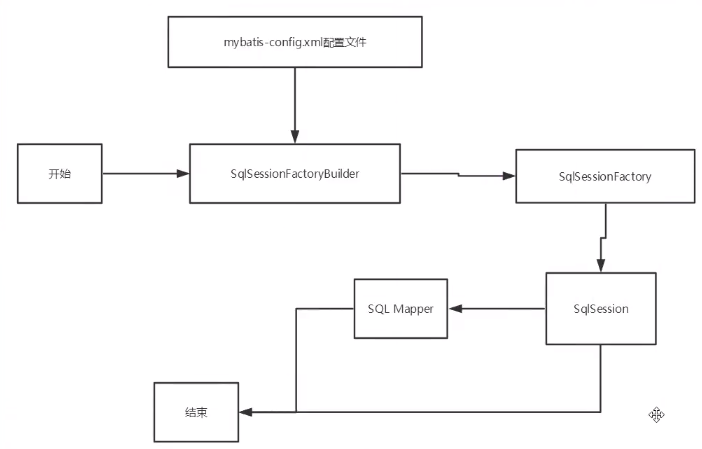
作用域和生命周期类别是至关重要的,因为错误的使用会导致非常严重的并发问题。
SqlSessionFactoryBuilder:
- 一旦创建了SqlSessionFactory,就不再需要它了
- 局部变量
SqlSessionFactory:
- 说白了就是可以想象为:数据库连接池
- SqlSessionFactory 一旦被创建就应该在应用的运行期间一直存在,没有任何理由丢弃它或重新创建另一个实例
- 因此 SqlSessionFactory 的最佳作用域是应用作用域
- 最简单的就是使用单例模式或者静态单例模式
SqlSession:
- 连接到连接池的一个请求
- SqlSession 的实例不是线程安全的,因此是不能被共享的,所以它的最佳的作用域是请求或方法作用域
- 用完之后需要赶紧关闭,否则资源被占用
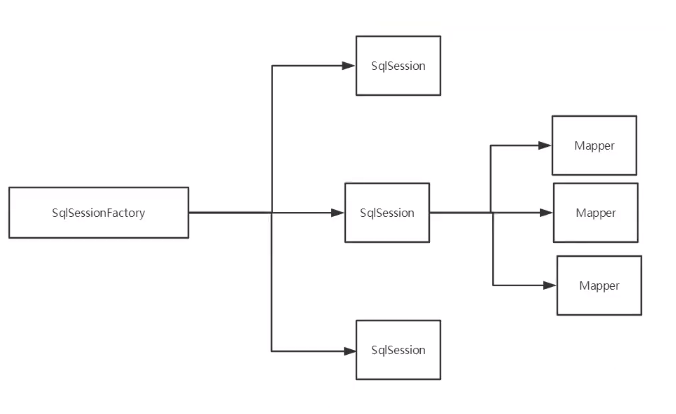
这里面的每一个Mapper,就代表一个具体的业务
5、解决属性名和字段名不一致的问题
1、问题
数据库中的字段:

新建一个项目,拷贝之前的,测试实体类字段不一致的情况
1 | |
测试出现问题
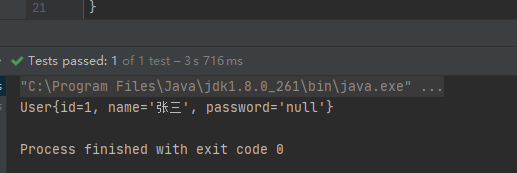
1 | |
解决方法:
起别名
1
2
3<select id="getUserById" parameterType="int" resultType="com.acacac.pojo.User">
select id,name,pwd as password from mybatis.user where id = #{id}
</select>
2、resultMap
结果集映射
1 | |
1 | |
- resultMap 元素是 MyBatis 中最重要最强大的元素
- ResultMap 的设计思想是,对简单的语句做到零配置,对于复杂一点的语句,只需要描述语句之间的关系就行了
- ResultMap 的优秀之处——你完全可以不用显式地配置它们
- 如果世界总使这么简单就好了
6、日志
6.1、日志工厂
如果一个数据库操作,出现了异常,我们需要排错。日志就是最好的助手
曾经:sout、debug
现在:日志工厂

- SLF4J
- LOG4J 【掌握】
- LOG4J2
- JDK_LOGGING
- COMMONS_LOGGING
- STDOUT_LOGGING 【掌握】
- NO_LOGGING
在Mybatis中具体使用哪一个日志实现,在设置中设定
STDOUT_LOGGING标准日志输出
在mybatis核心配置文件中,配置我们的日志
1 | |

6.2、Log4j
- Log4j是Apache的一个开源项目,通过使用Log4j,我们可以控制日志信息输送的目的地是控制台、文件、GUI组件
- 我们也可以控制每一条日志的输出格式
- 通过定义每一条日志信息的级别,我们能够更加细致地控制日志的生成过程
- 通过一个配置文件来灵活地进行配置,而不需要修改应用的代码
1.先导入log4j的包
1 | |
2.log4j.properties
1 | |
3.配置log4j为日志的实现
1 | |
4.Log4j的使用,直接测试刚才的查询
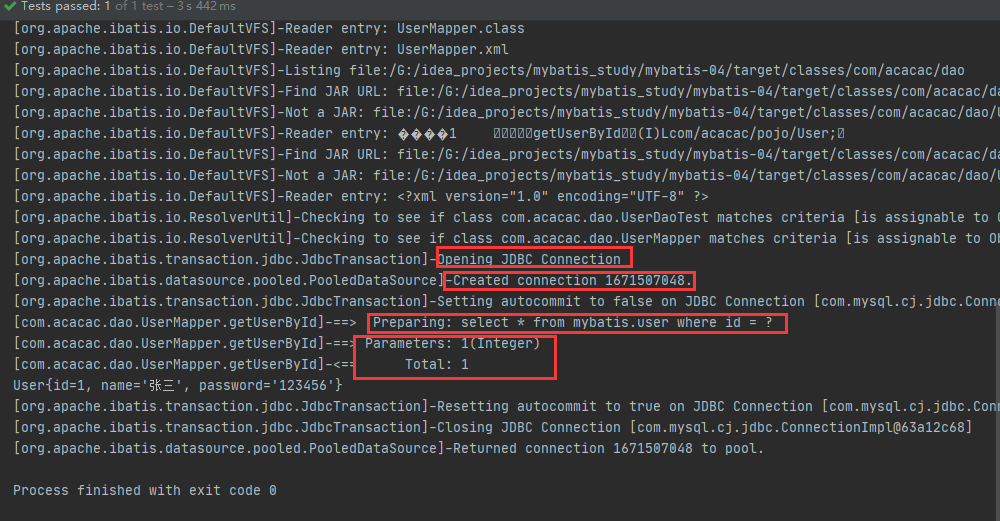
简单使用
1.在要使用Log4j的类中,导入包 import org.apache.log4j.Logger;
2.日志对象,参数为当前类的class
1 | |
3.日志级别
1 | |
问题:生成log文件打不开
解决:https://blog.csdn.net/weixin_43837880/article/details/111567307

7、分页
思考:为什么要分页?
- 减少数据的处理量
7.1、使用Limit分页
1 | |
使用Mybatis实现分页,核心是SQL
1.接口
1 | |
2.Mapper.xml
1 | |
3.测试
1 | |
7.2、RowBounds分页(不常用)
不使用SQL实现分页
7.3、分页插件
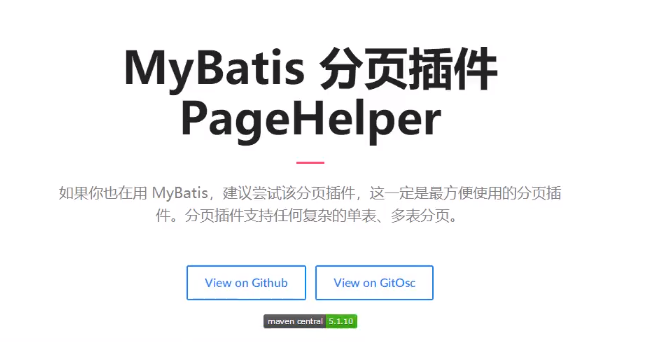
了解即可
8、使用注解开发
8.1、面向接口编程
- 根本原因:解耦,可拓展,提高复用,分层开发中,上层不用管具体的实现,大家都遵守共同的标准,使得开发变得容易,规范性更好
- 在一个面向对象的系统中,系统的各种功能是由许许多多不同对象协作完成的。在这种情况下,各个对象内部是如何实现自己的,对系统设计人员来讲就不那么重要了;
- 而各个对象之间的协作关系则成为系统设计的关键。消到不同类之间的通信,大到各模块之间的交互,在系统设计之初都是要着重考虑的,这也是系统设计的主要工作内容。面向接口编程就是按照这种思想来编程。
关于接口的理解
- 接口从更深层次的理解,应是定义(规范,约束)与实现(名实分离的原则)的分离
- 接口本身反映了系统设计人员对系统的抽象理解
- 接口应有两类:
- 第一类是对一个个体的抽象,它可对应为一个抽象体(abstract class);
- 第二类是对一个个体某一方面的抽象,即形成一个抽象面(interface);
- 一个个体可能有多个抽象面。抽象面与抽象体是有区别的
三个面向区别
- 面向对象是指,我们考虑问题时,以对象为单位,考虑它的属性和方法
- 面向过程是指,我们考虑问题时,以一个具体的流程(事务过程)为单位,考虑它的实现
- 接口设计与非接口设计是针对复用技术而言的,与面向对象(过程)不是一个问题,更多的体现就是对系统整体的架构
8.2、使用注解开发
1.注解在接口上实现
1 | |
2.需要在核心配置文件中绑定接口
1 | |
3.测试
本质:反射机制实现
底层:动态代理

Mybatis详细的执行流程
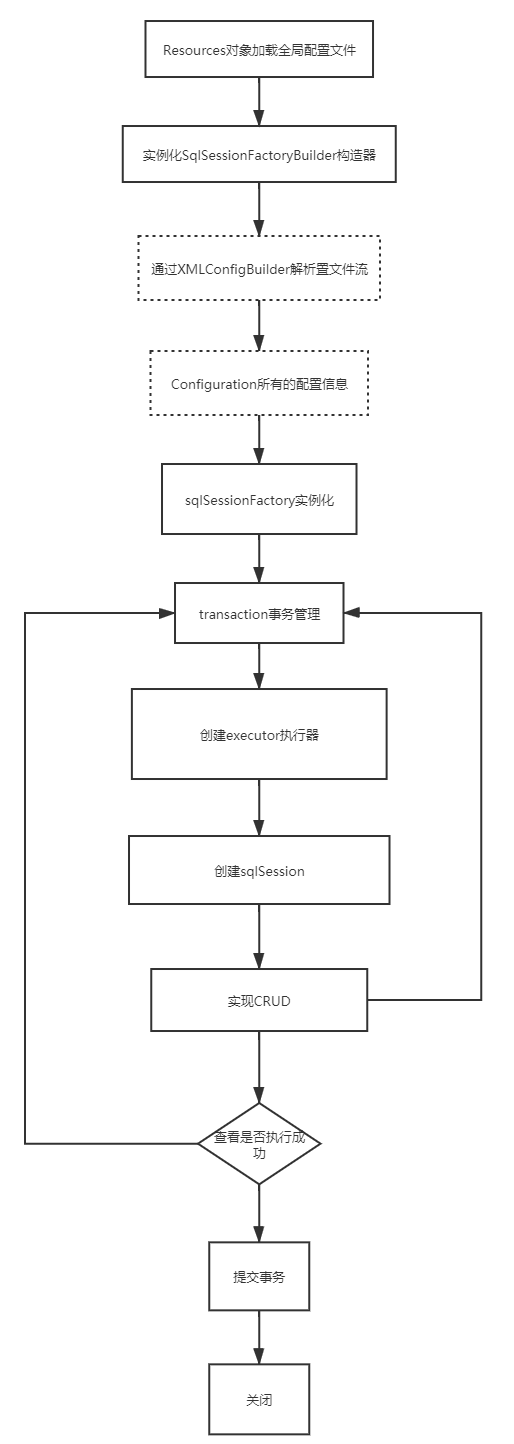
8.3、CRUD
我们可以在工具类创建的时候实现自动提交事务
1 | |
编写接口,增加注解
1 | |
测试类
【注意:我们必须要将接口注册绑定到我们的核心配置文件中】
关于@Param()注解
- 基本类型的参数或者String类型,需要加上
- 引用类型不需要加
- 如果只有一个基本类型的话,可以忽略,但是建议都加上
- 我们在SQL中引用的就是我们这里的@Param()中设定的属性名
#{} ¥{}区别
尽量使用#{},前者可以防止SQL注入,后者不行
9、Lombok
1 | |
- Java library
- plugs
- build tools
- with one annotation your class
使用步骤:
1.在IDEA中安装Lombok插件
2.在项目中导入lombok的jar包
3.在实体类上加注解即可
1
2
3@Data
@AllArgsConstructor
@NoArgsConstructor1
2
3
4
5
6
7
8
9
10
11
12
13
14
15
16
17
18@Getter and @Setter
@FieldNameConstants
@ToString
@EqualsAndHashCode
@AllArgsConstructor, @RequiredArgsConstructor and @NoArgsConstructor
@Log, @Log4j, @Log4j2, @Slf4j, @XSlf4j, @CommonsLog, @JBossLog, @Flogger, @CustomLog
@Data
@Builder
@SuperBuilder
@Singular
@Delegate
@Value
@Accessors
@Wither
@With
@SneakyThrows
@val
@var说明:
1
2
3
4
5@Data:无参构造,get、set、toString、hashcode、equals
@AllArgsConstructor
@NoArgsConstructor
@Getter
@Setter
10、多对一处理
多对一:
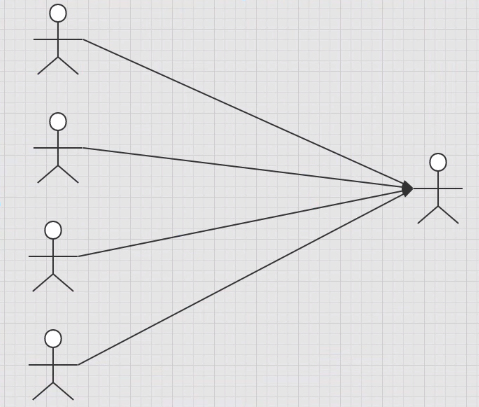
- 多个学生,对应一个老师
- 对于学生这边而言,关联.. 多个学生,关联一个老师 【多对一】
- 对于老师而言,集合,一个老师,有很多学生 【一对多】

SQL:
1 | |
测试环境搭建
- 1.导入lombok
- 2.新建实体类Teacher,Student
- 3.建立Mapper接口
- 4.建立Mapper.xml文件
- 5.在核心配置文件中绑定注册我们的Mapper接口或文件 【方式很多,随心选】
- 6.测试查询是否能够成功
按照查询嵌套处理
1 | |
按照结果嵌套处理
1 | |
回顾Mysql多对一查询方式
- 子查询
- 联表查询
11、一对多处理
比如:一个老师拥有多个学生
对于老师而言,就是一对多的关系
环境搭建
实体类
1 | |
1 | |
按照结果嵌套处理
1 | |
按照查询嵌套处理
1 | |
小结
- 1.关联 - association 【多对一】
- 2.集合 - collection 【一对多】
- 3.javaType & ofType
- javaType用来指定实体类中属性的类型
- ofType用来指定映射到List或者集合中的pojo类型,泛型中的约束类型
注意点:
- 保证SQL的可读性,尽量保证通俗易懂
- 注意一对多和多对一中,属性名和字段的问题
- 如果问题不好排查错误,可以使用日志,建议使用Log4j
12、动态SQL
==什么是动态SQL:动态SQL就是指根据不同的条件生成不同的SQL语句==
1 | |
搭建环境
1 | |
创建一次基础工程
1.导包
2.编写配置文件
3.编写实体类
```java
@Data
public class Blog {private int id; private String title; private String author; private Date createTime; private int views;}
1
2
3
4
5
6
7
8
9
10
11
12
13
14
15
16
17
- 4.编写实体类对应Mapper接口和Mapper.xml文件
## IF
```xml
<select id="queryBlogIF" parameterType="map" resultType="com.acacac.pojo.Blog">
select * from mybatis.blog where 1=1
<if test="title != null">
and title = #{title}
</if>
<if test="author != null">
and author = #{author}
</if>
</select>
choose (when, otherwise)
1 | |
trim (where, set)
1 | |
1 | |
==所谓的动态SQL,本质还是SQL语句,知识我们可以在SQL层面,去执行一个逻辑代码==
Foreach
1 | |


1 | |
==动态SQL就是在拼接SQL语句,我们只要保证SQL的正确性,按照SQL的格式,去排列组合即可==
建议:
- 先在Mysql中写出完整的SQL,再对应的去修改成为我们的动态SQL实现通用即可
SQL片段
有的时候,我们可能会将一些功能的部分抽取出来,方便复用
1.使用SQL标签抽取公共的部分
1
2
3
4
5
6
7
8<sql id="if-title-author">
<if test="title != null">
title = #{title}
</if>
<if test="author != null">
and author = #{author}
</if>
</sql>2.在需要使用的地方使用include标签引用即可
1
2
3
4
5
6<select id="queryBlogIF" parameterType="map" resultType="com.acacac.pojo.Blog">
select * from mybatis.blog
<where>
<include refid="if-title-author"></include>
</where>
</select>
注意事项:
- 最好基于单表来定义SQL片段
- 不要存在where标签
13、缓存(了解)
13.1、简介
1 | |
1.什么是缓存【Cache】?
- 存在内存中的临时数据
- 将用户经常查询的数据放在缓存(内存)中,用户去查询数据就不用从磁盘上(关系型数据库数据文件)查询,从缓存中查询,从而提高查询效率,解决了高并发系统的性能问题。
2.为什么使用缓存?
- 减少和数据库的交互次数,减少系统开销,提高系统效率。
3.什么样的数据能使用缓存?
- 经常查询并且不经常改变的数据。【可以使用缓存】
13.2、Mybatis缓存
- MyBatis包含一个非常强大的查询缓存特性,它可以非常方便地定制和配置缓存。缓存可以极大的提升查询效率
- MyBatis系统中默认定义了两级缓存:一级缓存和二级缓存
- 默认情况下,只有一级缓存开启。(SqlSession级别的缓存,也称为本地缓存)
- 二级缓存需要手动开启和配置,他是基于namespace级别的缓存
- 为了提高扩展性,MyBatis定义了缓存接口Cache。我们可以通过实现Cache接口来自定义二级缓存
13.3、一级缓存
- 一级缓存也叫本地缓存:SqlSession
- 与数据库同一次绘画期间查询到的数据会放在本地缓存中
- 以后如果需要获取相同的数据,直接从缓存中拿,没必须再去查询数据库
测试步骤:
- 1.开启日志
- 2.测试在一个Session中查询两次相同记录
- 3.查看日志输出
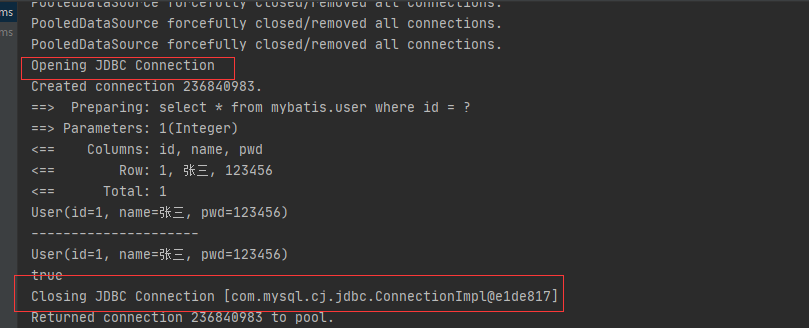
缓存失效的情况:
1.查询不同的东西
2.增删改操作,可能会改变原来的数据,所以必定会刷新缓存
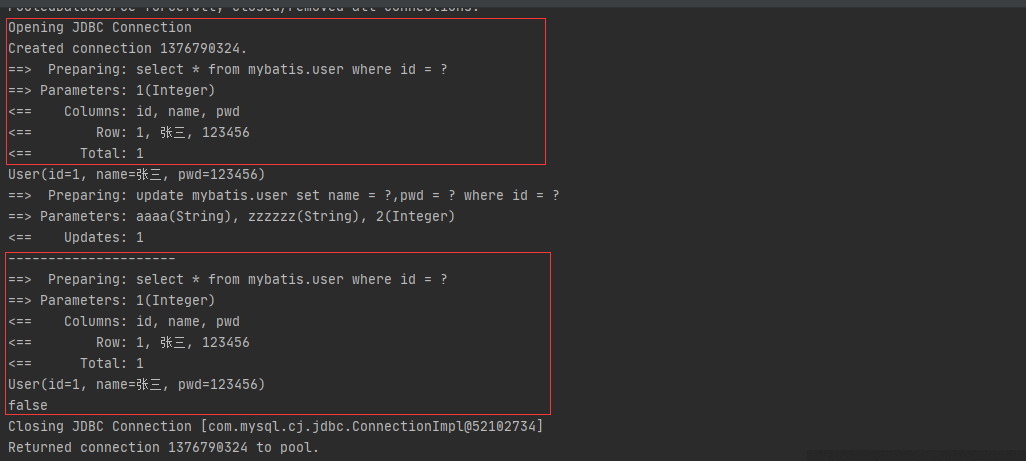
3.查询不同的Mapper.xml
4.手动清理缓存
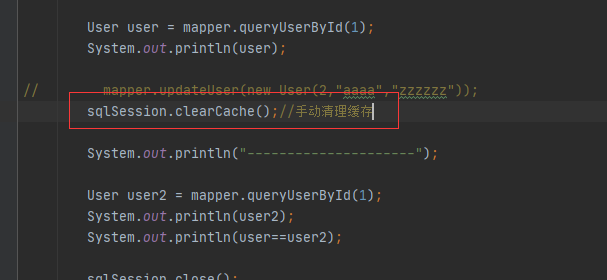
小结:一级缓存默认是开启的,只在一次SqlSession中有效,也就是拿到连接到关闭连接这个区间段
一级缓存就是一个Map
13.4、二级缓存
- 二级缓存也叫全局缓存,一级缓存作用域太低了,所以诞生了二级缓存
- 基于namespace级别的缓存,一个名称空间,对应一个二级缓存
- 工作机制
- 一个会话查询一条数据,这个数据就会被放在当前会话的一级缓存中
- 如果当前会话关闭了,这个会话对应的一级缓存就没了;但是我们想要的是,会话关闭了,一级缓存在中的数据被保存到二级缓存中
- 新的会话查询信息,就可以从二级缓存中获取内容
- 不同的mapper查出的数据会放在自己对应的缓存(map)中
步骤:
1.开启全局缓存
1
2<!--显式的开启全局缓存-->
<setting name="cacheEnabled" value="true"/>2.在要使用二级缓存的Mapper中开启
1
2<!--在当前Mapper.xml中使用二级缓存-->
<cache/>也可以自定义参数
1
2<!--在当前Mapper.xml中使用二级缓存-->
<cache eviction="FIFO" flushInterval="60000" size="512" readOnly="true"/>3.测试
1.问题:我们需要将实体类序列化,否则就会报错
1
Caused by: java.io.NotSerializableException: com.acacac.pojo.User
小结:
- 只要开启了二级缓存,在同一个Mapper下就有效
- 所有的数据都会先放在一级缓存中
- 只有当前会话提交,或者关闭的时候,才会提交到二级缓存中
13.5、缓存原理

13.6、自定义缓存-ehcache
1 | |
要在程序中使用ehcache,先要导包
1 | |
在mapper中指定使用我们的ehcache实现
1 | |
ehcache.xml
1 | |
Redis数据库做缓存 K-V
参考:狂神说
本博客所有文章除特别声明外,均采用 CC BY-SA 4.0 协议 ,转载请注明出处!